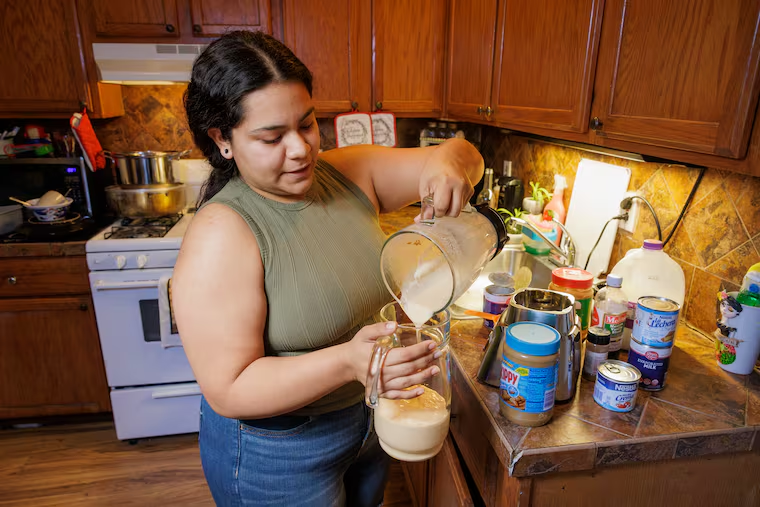Torito, a creamy Mexican cocktail, hasn’t hit mainstream America—yet. This mother-daughter duo is bringing it to Philadelphia.
Originating from the early 1800s, torito is a beloved cocktail native to Veracruz, Mexico. This mother-daughter duo wants to introduce the U.S. to it.

There’s an undeniable glow that emanates from Katherine Lopez’s face when she talks about Mexico.
It creeps up on her when she shares memories of her summers visiting her mother’s hometown in coastal Veracruz, like the tortillero she faithfully buys warm tortillas and masa from every time he rides by her grandparents’ house on his motorcycle. Or the unique veracruzano foods she enjoys, like “green spaghetti,” pasta cooked in a charred poblano sauce. Now, Lopez’s goal is to bring a taste of Veracruz to Philly through a beloved regional cocktail: Torito.
Originated in the early 1800s, this thick and creamy cocktail was created when sugar cane workers would fix themselves a beverage after an exhausting day harvesting fields. A combination of sweetened condensed and evaporated milks with cane liquor and peanuts or local fruits, the cocktail reenergized the laborers, who began calling it torito — or “little bull” — because they felt it gave them the strength of a bull.
Torito has grown in popularity since then, passed down through generations of Veracruzano families and primarily enjoyed around holidays and special occasions. Some have even begun commercializing the drink; Lopez remembers a recent trip to Veracruz where she saw a torito store selling the classic cocktail in a variety of less traditional flavors, such as pistachio or strawberry.
“It spread like a little rumor,” Lopez smiled as she stood in her kitchen preparing her own batch of torito.
While torito has long been a favorite tradition in Veracruz, the little rumor stopped there. Many Mexicans outside of Veracruz aren’t familiar with the drink, Lopez said, and she’s been introducing Latinos and non-Latinos alike to the drink in Philly. People often assume Lopez is talking about Coquito, the better-known Puerto Rican “eggnog” flavored with coconut. She hasn’t found torito at Mexican restaurants in the Philly area, and hasn’t seen it mass-produced outside Mexico. Indeed, when The Inquirer reached out to numerous local scholars on Latin American food and culture for comment on this story, they all sent the same response: they had never heard of torito before.
But for Lopez and her family, torito has been a lifelong staple. A wide grin spreads across Lopez’s face when she talks about the drink — not just because of its flavor, but rather because of the memories associated with it. Whether it’s Christmas or just a dinner hosting guests, torito is poured around the table on the rocks while family and friends talk, laugh, and connect with each other. Lili Morales, Lopez’s mother, said even when she was too young to drink alcohol, she and her other underage family members were allowed to dip a finger in or take a sip of the coveted drink — and the more daring kids would even sneak a glass away from the crowd.
“No matter what occasion, you’re still coming together and everyone’s having fun,” Lopez said.
It’s that communal spirit, from the sugar cane workers to family and friends, that torito was founded in.
The drink is relatively simple to make, at least in Lopez’s opinion. In her North Philly home, the interior of which is painted orange and royal blue in homage to the house colors in Mexico (“I picked them out,” Lopez beamed), she walked back and forth from a pantry shelf to the counter as she pulled out each ingredient. Cans of evaporated milk and sweetened condensed milk were neatly placed around a large tub of Jif peanut butter, small containers of Mexican vanilla extract, and cinnamon.
For years, Lopez had been telling her mom that they should start selling torito to other people. It wasn’t until the rest of their extended family made the same suggestion that Lopez and Morales finally decided to take the plunge this past holiday season.
Lopez and Morales concocted multiple flavors: strawberry, Nutella, coffee, and the original peanut. Lopez’s cousin started telling her colleagues about it, and they quickly sold over 30 bottles within a few weeks. Now, they’re planning on expanding their reach beyond word of mouth. They’ve created bilingual social media profiles for their torito in hopes of bringing the drink to the homes of Philadelphians across the city.
Of course, Lopez and Morales are aware of the risk of appropriation when introducing a new culinary item outside of its original country. But they would love to see torito take off in the U.S. — to them, it’s a way of sharing their culture, and they hope people will always remember Veracruz when they sip it.
“Whenever someone ordering it says it’s for sharing with others, it’s always that excitement that we’re getting more people to know about it,” Lopez said. “And we’re bringing people together as well.”